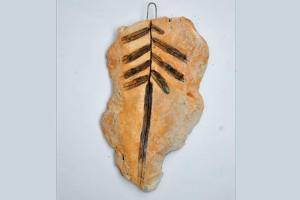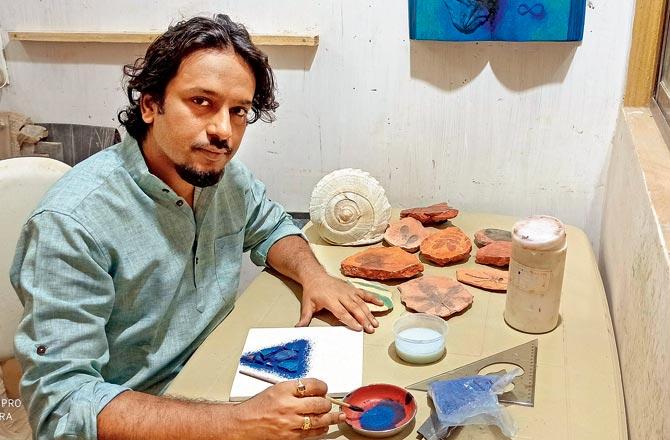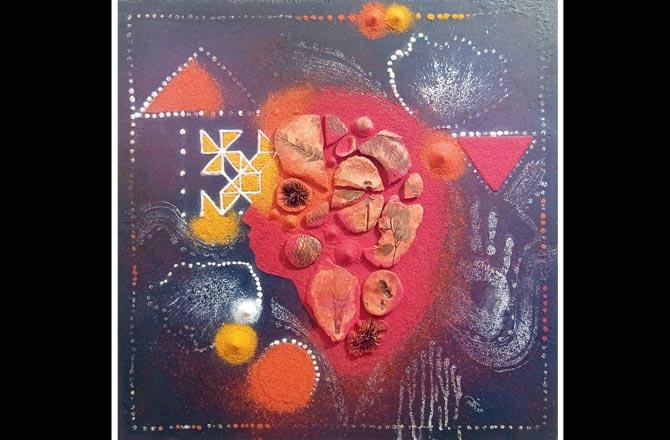I was elated by the news of the possibility of a Corona vaccine; it was a refreshing feeling, even if the everyday reality hadnt changed.

A fossil made by Onkar Kshirsagar in the 2019 Aarey Residency, sponsored by Art Oxygen. It was part of the larger installation named Dead Tree
 If an artist feels low, it shows, as it does in visual artist Onkar Kshirsagar's combined art mix-media creations spanning over last three months. Immediately after the national lockdown was imposed on March 26, Kshirsagar started visualising a barren black-and-white prakruti (nature) image. The national mood was somber and it reflected in his use of black rangoli, feathers, terracotta clay and ceramics.
If an artist feels low, it shows, as it does in visual artist Onkar Kshirsagar's combined art mix-media creations spanning over last three months. Immediately after the national lockdown was imposed on March 26, Kshirsagar started visualising a barren black-and-white prakruti (nature) image. The national mood was somber and it reflected in his use of black rangoli, feathers, terracotta clay and ceramics.
Three mix-media works—titled Night, The Day and My Moon—on which he spent time in April, also followed the same colour scheme, spelling out the desolation. In fact, the home-bound 36-year-old chuckles while clarifying that his moon is not a romantic 'chanda', but an intriguing satellite created with white rangoli on plywood. "When you are trapped in your flat and a pandemic derails usual human activity, the sun, moon and stars emit gloomy thoughts. I used to count each day, and yet to no avail," says the artist, who also teaches art at a Borivli school. He currently works from his Charkop flat, unable to access his studio in the neighbourhood.
ADVERTISEMENT

Onkar Kshirsagar's creation in the solo exhibition titled, Nature, Human and Culture, which was on display in November 2019 at Artists Centre, Kala Ghoda
Kshirsagar recalls his recourse to the pink and red shades, for creating My Earth, around May 3, a time when the lockdown reality for Mumbai was fully established, but some areas in Maharashtra witnessed a partial lift in curfew. "I was elated by the news of the possibility of a Corona vaccine; it was a refreshing feeling, even if the everyday reality hadn't changed."
The artist started using bright rangoli colours in his works in May and June. As he shared work on social media properties and his website, he was told that he was gradually getting close to the vibrant fossils he created in the April 2019 Aarey forest residency, while living with Warli families. "The arc dawned on me only after it was brought to my notice by my Instagram followers. I feel am slowly coming back to the restorative colour-filled constructs."

Kshirsagar is an alumna of LS Raheja College of Arts and teaches art at a school in Borivli
Fossils have formed an essential element of Kshirsagar's oeuvre since 2017; but they bind his current lockdown works immensely. His definition of fossils—"anything that locks the current times for the future"—perennially guides his creative process. In a palaeontologist's lexicon, a fossil constitutes preserved remains, impressions or traces of a once-living thing. Fossils help in the study of the past geological age because a specimen dates back to minimum 10,000 years, and the oldest can stretch up to billion years back in time. But, this geological timescale doesn't work in Kshirsagar's universe. For him, a banyan tree trunk (saved from being hacked) is a fossil. He notices preservation worth in an eye-catchy star fish, a bird's feather, a jackfruit skin, a wounded dragonfly and, not to forget, a ripe corn cob. He has so far created around 300 fossils of varying sizes from the natural elements around him; some have been modified and put to use in other works, some are in his studio display.
There are two reasons why Kshirsagar is fixated on fossils. First, he feels close to natural objects and doesn't want them to vanish from his work space. For instance, as one fish from his home aquarium died, he took its mould; so that it could be locked and treasured; a memory of his moments with what once moved and heaved. Second, he is worried if the natural fossilisation will be allowed in the current ecological system. Usually fossils are formed when a living organism dies in a water body and is buried in silt, which hardens over time. But will growing urbanisation allow this fossilisation? "I wonder if there will be rivers in the first place to preserve traces of bio-diversity? I want to therefore, take it upon myself to conserve whatever I want to pass on to a younger generation."

Kshrisagar's self-portrait, a silhouette outlined by fossils
Ever since his LS Raheja School of Art days, Kshirsagar has been attracted to the aesthetic emerging out of natural landscapes. That has also ruled his choice of medium. For instance, he uses ample water-based clay that sculptors like his father Ganesh Kshirsagar constantly experiment with while rendering Gods and Goddesses. Similarly, he indulges in papier-mache, terracotta clay, transparent resin, and of course, rangoli. His scheme of things showed in both his solo exhibitions last year—"Search" at CO3 art gallery and "Nature, Human, Culture" at Kala Ghoda Artist Centre. He says rangoli is the jewellery for Mother Earth; it underlines the cultural imprint of humans on the planet, just as fossils encapsulate nature in a condensed form. He has also used the red ochre Geru powder in many of his projects, that go close to the Warli painting chowk he treasures as a rich form of community art.
Kshirsagar expresses himself through his material. In the last fortnight, he has arrived at a self-portrait; a silhouette outlined by fossils again. "The lockdown curbs are not going to be lifted soon. I feel my portrait is therefore my way of breaking the monotone and coming out in the open," he says. The portrait has handprints in the background, which speak of his adherence to pre-historic cave motifs.
To be a fossil, one needs to be lucky to live long enough. Kshirsagar feels Mumbai needs to be sensitive to this fact in the context of creatures, which are becoming extinct. Much like Aarey, his next fossil outreach is going to be on the Gorai beach where rare aquatic creatures have caught his attention. Once the lockdown lifts in Mumbai, he intends to collect samples from most green spaces in the city. From the rare moth on the kitchen window, to the dried banyan root in the Sanjay Gandhi National Park, Kshirsagar wants to memorialise all living wonders in his fossil project.
Sumedha Raikar-Mhatre is a culture columnist in search of the sub-text. You can reach her at sumedha.raikar@mid-day.com
Catch up on all the latest Mumbai news, crime news, current affairs, and a complete guide from food to things to do and events across Mumbai. Also download the new mid-day Android and iOS apps to get latest updates.
Mid-Day is now on Telegram. Click here to join our channel (@middayinfomedialtd) and stay updated with the latest news
 Subscribe today by clicking the link and stay updated with the latest news!" Click here!
Subscribe today by clicking the link and stay updated with the latest news!" Click here!







